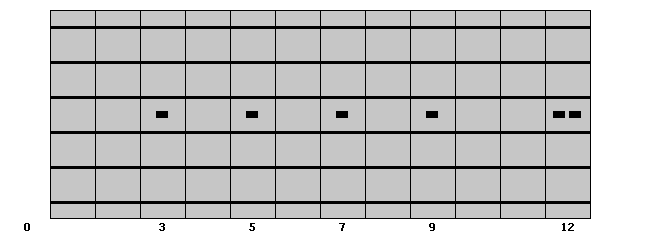|
NEW!! CHECK OUT THE MAJOR SCALES AND MODES TRAINER BELOW.
Below is the complete full color map of C Major. The colors are explained in the following pages. Click on the All Notes - No Color link to see all the notes. Then click on Piano Fretboard to see the sharp notes (like the black piano keys). If we take out the black notes, we are left with the key of C Major. The black notes form a pentatonic scale.
All Notes - No Color |
Piano Fretboard |
Map of C Major
Major Scales and Modes
NEW. Below you can study the Major Scales and Modes. Read each major scale across. Between the 3 and 4 degree, and 7 and 8 degree of any major scale, there is a half-step (move one fret). A whole step is 2 frets. Major Scale: whole step, whole step, half-step, whole step, whole step, whole step, half-step. Notice the key of C has natural half steps at E F and B C. The key of G has one sharp, F sharp. This is so that you end the G major scale with a half-step. The key of D has 2 sharps. G is the 5th note of the C scale. D is the 5th note of the G scale and so on until you have the chart below. This is called the cycle of fifths.
For further explaination, go to the discussion on the C Major Modes.
| Major |
Dorian |
Phrygian |
Lydian |
Mixolydian |
Minor |
Locrean |
Major |
| 1 |
2 |
3 |
4 |
5 |
6 |
7 |
8 |
| C |
D |
E |
F |
G |
A |
B |
C |
| G |
A |
B |
C |
D |
E |
F# |
G |
| D |
E |
F# |
G |
A |
B |
C# |
D |
| A |
B |
C# |
D |
E |
F# |
G# |
A |
| E |
F# |
G# |
A |
B |
C# |
D# |
E |
| B |
C# |
D# |
E |
F# |
G# |
A# |
B |
| F# |
G# |
A# |
B |
C# |
D# |
F |
F# |
| C# |
D# |
F |
F# |
G# |
A# |
C |
C# |
| G# |
A# |
C |
C# |
D# |
F |
G |
G# |
| D# |
F |
G |
G# |
A# |
C |
D |
D# |
| A# |
C |
D |
D# |
F |
G |
A |
A# |
| F |
G |
A |
A# |
C |
D |
E |
F |
Below is the fretboard that is used in this book. There are 12 frets with black marks at the 3rd, 5th, 7th, 9th and 12th frets. The double dots indicate the 12th fret, which is at the halfway point of any string. Although guitars have more than 12 frets, the part of the neck above the 12th fret is an exact replica of the lower part only an octave higher (the octave is discussed in further detail in the following sections). Therefore in order to keep just the minimum amount needed, yet allowing a complete analysis of scales and chords, 12 frets is all that is required. Some diagrams in this book will show more than 12 frets for clarity. There are 6 thick horizontal lines representing the six strings. The bottom string is the low E, and as you move up, there is the A, D, G, B and high E strings.
|
|

